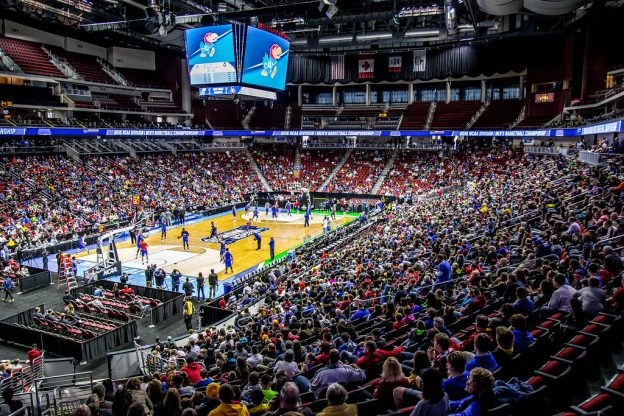Zachary Finkelman – In recent years, the world of college sports has undergone a seismic shift. The traditional model of the “student-athlete” is being challenged, as the National Collegiate Athletic Association (NCAA) grapples with the ever-evolving landscape of collegiate compensation. The fundamental rule seems simple enough: student-athletes can’t accept money for playing their sports. However, this rule stands in stark contrast to the fact that the NCAA’s multi-billion-dollar industry thrives on these athletes’ participation in their respective sports. This apparent contradiction has sparked a significant debate, and the NCAA is caught in the crosshairs.
On Tuesday October 17, 2023, the NCAA went before Congress to express that for college sports to modernize, the athletes must remain students. At a Senate hearing, NCAA President Charlie Baker was among many representatives that spoke about the idea of student athletes being deemed employees of their schools. Baker, as well as Notre Dame athletic director, Jack Swarbrick, explained how “inaction by Congress would lead to a series of court rulings that declare college athletes as employees,” which would dilute the idea of amateurism. Labeling student-athletes as “employees” would usher in labor contracts, revenue sharing, and an array of benefits previously unexplored in college athletics, but with the challenge of non-uniform implementation across different states. While uniformity through federal legislation sounds convenient, political implications hinder its possibility. Republicans are willing to create a bill, but one that is largely limited to solely replacing a patchwork of state name, image, and likeness (NIL) laws with a national standard. Democrats, on the other hand, want a bill that covers greater athlete protections, such as long-term healthcare and other benefits for players.
The hearing also touched on NIL, transfer rules, and athlete health and safety. Most notably, Baker, in his written testimony, expressed that the NCAA is “open to working with Congress” to construct a federal law to address changes aimed at benefitting student athletes. The benefits include scholarships that provide financial support for athletes who suffer injuries or are no longer part of the team, and funding that enables athletes to continue their undergraduate education even after their eligibility has concluded. Tony Petitti, the commissioner of the Big Ten, mentioned that several schools within the conference “are open to providing additional health and welfare benefits for athletes, and for athletes to receive benefits even greater than that directly by institutions.”
The ultimate motive of the NCAA in this recent development is for federal lawmakers to bail out college athletics authority in a way the courts have refused to do so. For example, in NCAA v. Alston, the Supreme Court upheld a district court ruling that the NCAA rules limiting education-related compensation violated Section 1 of the Sherman Act. After reviewing the relevant evidence, the district court determined that the NCAA’s compensation rules were not per se illegal, but the NCAA’s rules limiting education-related compensation unreasonably restrained trade. In doing so, the Court essentially paved the way for student-athletes to legally receive NIL opportunities.
However, it may be time for the NCAA to accept reality. It is difficult to argue for amateurism when collegiate sports is a billion dollar business. The NCAA made over $1 billion in revenue in 2022. College sports, particularly in major programs, generate substantial revenue through ticket sales, merchandise, sponsorships, and broadcasting rights. For example, the University of Michigan alone produced $210 million in total revenue for the 2022-23 year.
As a result of the political implications hindering the ability for a uniform federal law, states have started enacting their own legislation specifically focused on NIL and the relationship between student athletes and compensation. In Florida, for example, Governor Ron DeSantis signed a bill in June 2020 allowing college athletes in the state to earn compensation for using their NIL. Under the Florida law, college athletes can enter into endorsement/sponsorship deals and receive compensation for their NIL rights without the threat of losing their athletic eligibility. In response to the changing landscape of college athletics, and its increased popularity, DeSantis amended the 2020 law on February 16, 2023. The new law no longer makes a clear, evident distinction between amateur collegiate athletics and professional sports. Compensation for an athlete’s NIL is now not limited to third parties unaffiliated with the athlete’s school. As a result, the law no longer stops college athletes in Florida from entering into agreements that conflict with their school’s team contract.
Florida’s NIL law, which other states are sure to replicate, flags many significant regulatory trends. There are potential tax considerations to address, as a college athlete’s earnings from NIL activities may become subject to taxation. The Internal Revenue Service (IRS) has not yet provided clear guidance on the tax treatment of NIL earnings, but it is reasonable to expect that this could come into play soon. Next, with college athletes in Florida now empowered to enter into contracts with sponsors and third parties, the likelihood of contract disputes leading to litigation may rise significantly. Further, as college athletes seek to maximize their NIL opportunities, there is likely to be a surge in the involvement of sports agents and advisors. Athletes will increasingly turn to representation to navigate the complexities of these opportunities, potentially reshaping the dynamics of college sports. Finally, this will most likely impact the amateur status of college athletes. The shift towards a more professionalized model of college sports, with opportunities for athletes to earn money from their abilities and performance, will challenge the traditional model. While the NCAA will remain a central figure in college sports, it is likely to face challenges to its traditional power and may need to evolve its rules and policies to accommodate the changing landscape of student athlete compensation and rights.


